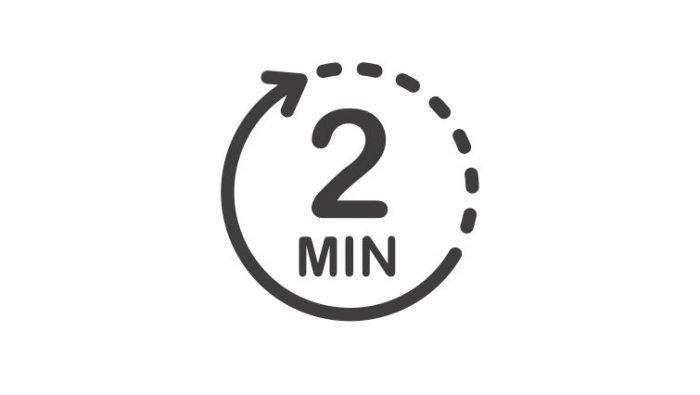The 2-Minute Rule: Stop Procrastinating and Start New Productive Habits at Work
 Publié le 1 October 2020
Publié le 1 October 2020
The 2-Minute Rule is an effective productivity method to avoid procrastination and stick to habits at work and in your personal life.
This spring while practicing isolation to slow the spread of COVID-19, many of us made a list of things we wished to accomplish and get done during this period. We were all looking for ways to fill the time and keep our minds occupied while so much seemed uncertain. Common goals included reading more books, learning a new musical instrument, completing an online learning course, gaining a new certification, exercising regularly, or even just putting on pants everyday.
My personal list consisted of practicing meditation, reading more, researching articles on financial independence and learning to play guitar. Like a great number of people, I was unable to accomplish every one of my lockdown goals. I put off a lot of these tasks and postponed the time needed to really work on these habits. Because there is one thing that all of us are good at: procrastination.
“I’ll start tomorrow, or maybe on Monday, or maybe the next week, or maybe on the 1st of the month…”
Sticking To New Habits Isn’t Easy
You are not alone in thinking like this. Studies have shown that as few as 19% of people are able to stick to new habits or resolutions. This means that as many as 8 out of 10 people aren’t able to make a goal and stick to it.
This is not purely the result of a lack of willpower or motivation, but oftentimes because of a simple lack of time. We all still have responsibilities and obligations everyday, and these can quickly take up our days and leave us feeling like there is little time for everything else.
Don’t Bite Off More Than You Can Chew
One reason for the lack of time is that many of the new habits or goals we choose are too demanding. We simply bite off more than we can chew. What usually happens is that we set big goals, and slowly lose motivation as we try to navigate complex schedules while juggling work and family obligations, leading to stress, anxiety and fatigue.
For example:
- It takes too much to exercise for another 30 minutes after a long day at work.
- It takes too much to power your way through 20 minutes of meditating.
- It takes too much to prepare an entire week’s worth of healthy meals every Sunday.
These are large activities that require serious time and effort, and sometimes we just can’t muster that much drive to follow through. This means we don’t repeat them enough to build habits, and we don’t incorporate these tasks into the daily routine of our lives.
Recently, I’ve been following a new simple rule that is helping me to avoid procrastination, learn new things and stick to new habits.
And the best part? It’s really quick and simple.
How To Use the 2-Minute Rule
The strategy behind the 2-Minute Rule is simple: When you start a new habit, choose something you can do in less than 2 minutes.
This does not mean that you can’t make large goals, but rather that you should break these large goals into smaller, more manageable steps. You’ll find that almost every habit can be scaled down into a 2 minute version.
“Read 1 chapter before bed” becomes “read 1 page”.
“Complete an entire workout” becomes “complete 1 set of exercises.”
“Meditate for 20 minutes” becomes “Close your eyes and breathe.”
“Fold all the laundry” becomes “fold 1 pair of socks.”
“Run 5 kilometres” becomes “run to the end of the block.”
By breaking down large goals into smaller pieces, it becomes much simpler to make small increments in time without feeling overwhelmed. Due to the fact that you’ll then accomplish a goal quickly, it is great motivation to link these increments together and keep going.
I was inspired by productivity consultant and author David Allen. He has his own 2-Minute Rule for improving productivity, which states: “If it takes less than 2 minutes, then do it now.”
Make It As Easy As Possible To Start Your New Habit
A new habit doesn’t need to feel like a big challenge. It can still lead to big changes, but you can accomplish this by making the first 2 minutes fairly easy. What we are really doing is creating “mini-habits”, which will naturally lead us down a more productive path.
Anyone can find the motivation and time to meditate for one minute, read one book page or hang up one piece of clothing. Once you realize that you can stick to these mini-habits, it becomes much easier to build them up into larger routines.
If you want to make it easier to see how mini-habits will lead to your desired outcomes, try mapping out your goals on a scale from “very easy” to “very hard”.
For example, running a marathon is very hard. Running a 5K is hard. Walking ten thousand steps is moderately difficult. Walking ten minutes is easy. And putting on your running shoes is even easier.
Your final goal might be to run a marathon, but your mini-habit is to put on your running shoes. That’s how you follow the 2-Minute Rule.
Why the 2-Minute Rule Works
It may be hard to believe that doing something for just a couple minutes can help to form long-lasting habits. The point, however, is not to only do one thing for a couple of minutes. The main point behind the 2-Minute Rule is mastering the habit of showing up.
If you have learned the basic skill of showing up, then it will be much easier to improve your habits and master a new routine. Instead of trying to be perfect from the very beginning, learn to do smaller and easier steps on a more consistent basis. You have to standardize before you can optimize.
As you master the art of showing up, the first 2 minutes simply become a ritual at the beginning of a larger routine. This is not merely a “hack” to make it easier to stick to new habits, but actually the ideal way to master a difficult skill.
The more you ritualize the beginning of a process, the more likely it becomes that you can slip into the state of deep focus that is required to accomplish large goals. Make it easy to start and the rest will follow.
An Effective Strategy to Build Your Desired Identity
The 2-Minute Rule may seem like a trick to some people. You know that the real goal is to do more than just 2 minutes, so it may feel like you’re trying to fool yourself. And if you know it’s a mental trick, why would you fall for it? The goal is not to trick yourself, but to reward yourself for taking the real steps that will lead to the outcomes that you want.
There is another reason that strategies like the 2-Minute Rule are effective: they reinforce the identity that you want to create for yourself. If you want to be the type of person who shows up at the gym 5 days a week, doing so in 2-minute increments rewards you for doing the real work to make this a reality. You’re not worried about getting in shape. You’re focused on becoming the type of person who doesn’t miss workouts. You’re taking the smallest action that confirms the type of person you want to be.
Fight Against Discouragement
We rarely think about change this way because everyone is consumed by the end goal. The problem is that sometimes the end goal seems so far away that we become discouraged before we reach it. The truth is that doing 1 push-up is better than doing none. Reading 1 page is better than not picking up a book at all. 1 minute of practicing your instrument is better than letting it collect dust.
Accomplishing small goals that lead to a big result is better than accomplishing nothing.
If you are struggling to stick to a new habit, create a new routine or learn a new skill, try breaking it down using the 2-Minute Rule. It’s a simple way to make changing your habits much easier.







